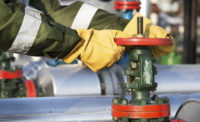5 fundamentals of protecting lone workers in the oil and gas industry

Depending on the parts of the oil and gas industry your company operates in, you’ll be well aware of the ever-changing hazards that your workers face.
Although there are many trends that impact health and safety efforts, from an aging workforce and generational divide to a greater reliance on the "gig economy" moving forward, there are also steps that all businesses can take to bring greater protection to their strategy right now and to enlist new tools dedicated to looking after their lone workers specifically.
Here we cover the five fundamental steps organizations can take towards achieving a greater health and safety strategy for their employees.
1.Identify your lone workers
The first and perhaps most important thing you need to do when in the planning stages is to identify who your lone workers actually are.
According to the HSE, lone workers are “those who work by themselves without close or direct supervision”, so these employees could just as easily be workers who do not operate within sight of anyone else as much as those who operate out on the roads.
Nailing down this information from the start means you can effectively identify and mitigate the risks they might face.
2.Plan to mitigate basic risks
No matter the industry, some of the health and safety basics remain the same. Employers are legally required to identify and mitigate hazards in the workplace as much as possible. Some of the most common causes of accidents at work include:
- Slips, trips and falls on the same level (29%)
- Handling, lifting or carrying (20%)
- Being struck by a moving object (10%)
- Violence (8%)
- Falls from height (8%)
In order to identify the risks that your workers may face, a thorough risk assessment must be performed. This can be completed through a mixture of speaking with employees, observing day-to-day operations and analysing which environmental and social hazards may be relevant to your workforce.
3.Offer the correct PPE
Some PPE can be obvious, including protective headgear and gloves that protect vulnerable areas of the body while working.
But if employees regularly find themselves working in environments that contain dangerous substances or are potentially explosive, then it absolutely essential that they are also given the correct equipment and PPE for these situations. Without it, the consequences could be catastrophic.
This equipment can include everything from anti-static clothing and shoes, to electronics and devices that will not cause a spark when knocked or dropped.
4.Protect workers on the road
A huge part of work in the oil and gas industry involves workers spending long stretches of time out on the road. This can cause a number of problems for worker wellbeing, including risks brought on by fatigued drivers, loss of communication with supervisors and head office, or unexpected illness, vehicle breakdowns and accidents at locations where assistance is not immediately available.
Where possible, employees asked to travel long distances should be accompanied and appropriate shift patterns decided.
When this is not possible, organizations should equip those working alone with lone worker alarms that ensure the user can raise an alert or get in touch with relevant people should an incident occur. These devices will also allow organizations to track the driver’s whereabouts while they are on the road.
5.Incorporate digital solutions
One of the biggest issues identified in ISHN’s report on health and safety trends in 2020 was the need for greater automation.
By enlisting technology such as mobile workforce management software and the aforementioned lone worker alarms, companies can have greater control over how they keep track of their remote workforce.
Lone workers, especially, benefit for the digital transformation of health and safety, as systems that can be used anywhere remotely allow them to feel safe even when they are not physically close to their teammates or supervisor.
As the industry continues to shift and change, it’s never been more important for health and safety leaders to not only ensure that the basic needs of their lone workers are met but to also look outside of the norm for new and innovative solutions.
Looking for a reprint of this article?
From high-res PDFs to custom plaques, order your copy today!





